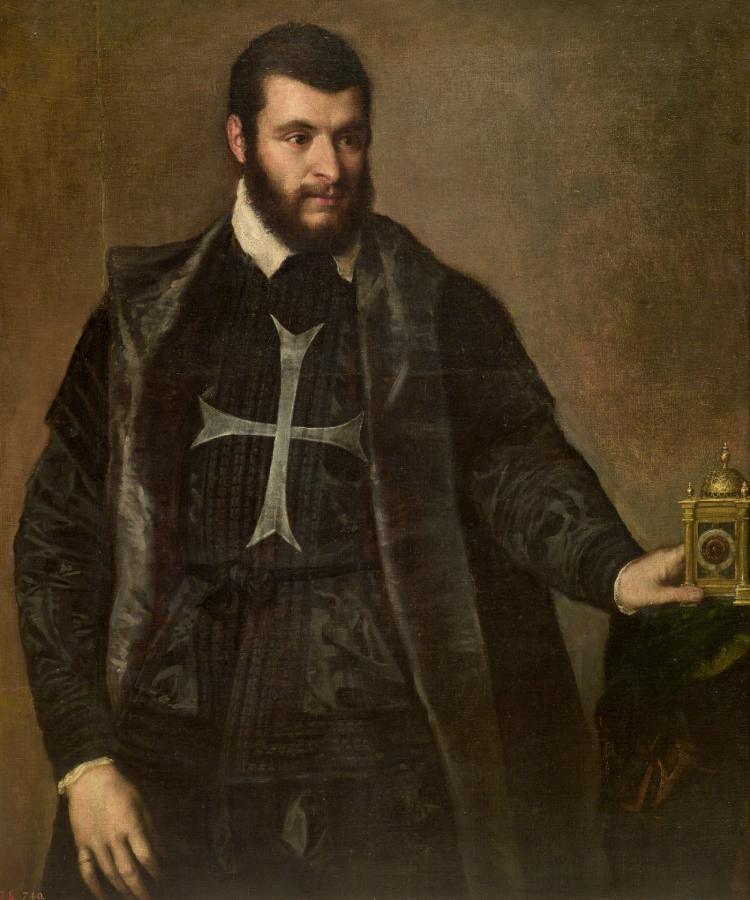Tiziano (c.1488-1576)
Ritratto di cavaliere con orologio (Portrait of a Knight with a Clock)
c.1550
Oil on canvas, 122 x 101 cm
Museo del Prado, Madrid
The unknown subject of this portrait has been identified, inconclusively, as either Gianello della Torre, a clockmaker at the Spanish court, or some member of the Cuccini family. Whether or not the figure is a Knight of Malta has been questioned due to supposed anomalies in the cross sewn onto his clothing, despite the fact that it is an enhanced octagonal cross of the Order of Malta, made of white cloth and worn in the manner stipulated by that order’s founding papal bull of 1153. The painting’s most striking element is the clock from which its name derives. A symbol of the temperance that should be shown by any ruler, it also alludes to the passing of time and the fleeting nature of life. Titian included clocks in portraits of aristocrats such as Cardinal Granvela, 1548 (Nelson-Atkins Museum of Art, Kansas City), Cardinal Crisoforo Madruzzo, 1552 (São Paulo Museum of Art) and Eleonora Gonzaga, Duchess of Urbino, 1538 (Uffizi, Florence). Their similar appearance in all these works suggests they were actually the same timepiece which probably belonged to the painter. Objects can be included in portraits for symbolic reasons, but they can also signal a model’s pastimes (the Dukes of Urbino, for example, collected clocks) or even allude to his or her name. It has been suggested that the gentleman depicted here may have been the writer and translator Giuseppe Horologgi (1520-1576), a member of the Venetian Donde dall’Orologio family -orologio means clock in Italian. Various circumstances support this theory, including the model’s special relation to the clock (this is the only portrait by Titian in which there is actual physical contact between the model and the object), which might be justified by his last name, and his friendship with Pietro Aretino and, through him, with Titian. However, there is no documentation indicating that Horologgi was a Knight of Malta. Moreover, any search for the gentleman’s identity should consider the provenance of this painting, which Niccolò Ludovisi gave to Philip IV as thanks for the state of Piombino. The Ludovisi collection drew mainly on the former Este de Ferrara collection, as the latter family had a longstanding relationship with Titian and also included various Knights of Malta over the course of the sixteenth century. Whoever this nobleman may be, his portrait is one of the few painted by Titian in the 1550s that did not belong to the imperial court. Finally, the presence of the clock may respond to purely compositional needs. X-rays have revealed that the model originally grasped a different object below his waist. That original position, with both arms practically parallel, may have been too stiff for Titian, who would have added the clock and placed the model’s hand on it. This seems to indicate that the painter was less concerned with the clock’s symbolic dimension than with the desire to bring greater dynamism to the figure, thus tempering the composition’s sense of stasis. Nobleman with a clock, c.1550, is in excellent condition and reveals its maker’s mastery at handling black and reproducing the qualities of clothing. This is clear in the impasto of the model’s white collar, which contrasts with the less brilliant whiteness of the cross, recreating the cloth with which it was made. (Falomir Faus, M., Titian ‘Nobleman with a clock’. In: Italian masterpieces from Spain’s royal court, Museo del Prado, National Gallery of Victoria Thames & Hudson, 2014, p.76)
